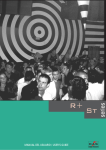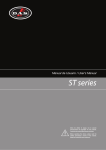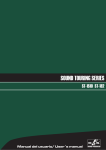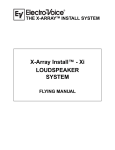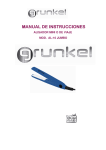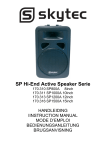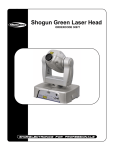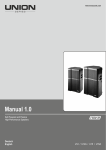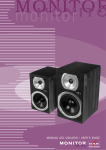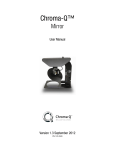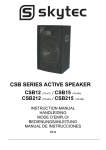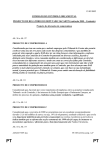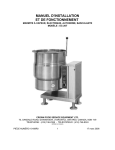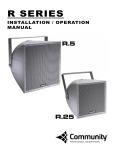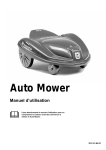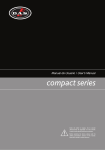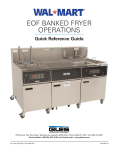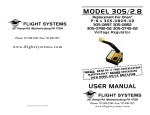Download series
Transcript
MANUAL DEL USUARIO / USER’S GUIDE St series R+ Precauciones de Seguridad Safety Precautions Sicherheitshinweise Règles de Sécurité El signo de exclamación dentro de un triángulo indica la existencia de importantes instrucciones de operación y mantenimiento en la documentación que acompaña al producto. The exclamation point inside an equilateral triangle is intended to alert the users to the presence of important operating and maintenance (servicing) instructions in the literature accompanying the product. Das Ausrufezeichen im Dreieck weist auf inhaltlich besonders wichtige Erklärungen des nebenstehenden Textes hin. Le point d'exclamation dans un triangle équilatéral alerte signale la présence d'informations importantes de fonctionnement et de maintenance dans le manuel qui accompagne le produit. El doble cuadrado indica equipo de Clase 2. The double square indicates Class 2 device. Das doppelte Viereck bedeutet daß es sich um ein Gerät der Klasse 2 handelt. Le double carré circonscrit indique un appareil de Classe 2. No exponga este equipo a lluvia o humedad. Do not expose this device to rain or moisture. Dieses Gerät nicht dem Regen oder extremer Feuchtigkeit aussetzen. Ne pas exposer l'appareil à la pluie ou à l'humidité. No emplace altavoces en proximidad a equipos sensibles a campos magnéticos, tales como monitores de televisión o material magnético de almacenamiento de datos. Do not place loudspeakers in proximity to devices sensitive to magnetic fields such as television monitors or data storage magnetic material. Plazieren Sie Lautsprecher nicht in der Nähe von Geräten die empfindlich auf magnetische Felder sind (z.B.: Fernsehmonitore, magnetische Datenmedien). Ne pas disposer ces enceintes à proximité d'appareils ou supports sensibles aux champs magnétiques tels que moniteurs vidéo, télévision ou diskettes et cassettes vidéo/audio. No existen partes ajustables por el usuario en el interior de este equipo. No user serviceable parts inside. Es sind keine vom Anwender einstellbaren Teile im Gerät enthalten. Aucune pièce est réparable par l'utilisateur à l´interieur. Altura máxima de seguridad desde el suelo a la base de la caja montada sobre trípode modelo TRD-2, pies a su máxima extensión: Maximum safety height from floor to bottom of enclosure when mounting on a TRD-2 tripod with legs fully open: Maximale Höhe des Unterteils der Box bis zum Boden, wenn auf dem Ständer TRD-2, mit voll aufgeklappten Gestell montiert: Distance maximum du sol à la base des enceintes montées sur le tripode TRD-2 à ouverture maxi des pieds: R-112 R-115 ST-015 ST-15 ST-32 R-112 R-115 ST-015 ST-15 ST-32 R-112 R-115 ST-015 ST-15 ST-32 R-112 R-115 ST-015 ST-15 ST-32 112 cm 99 cm 115 cm 112 cm 107 cm El resto de los modelos no se pueden montar en trípode. 112 cm 99 cm 115 cm 112 cm 107 cm The rest of the models are not tripod mountable. 112 cm 99 cm 115 cm 112 cm 107 cm Restliche Typen können nicht auf Lautsprecherstative montiert werden. 112 cm 99 cm 115 cm 112 cm 107 cm Les autres modeles ne sont pas montables sur tripode. ÍNDICE CONTENTS Precauciones de seguridad Safety Precautions 1. Introducción 1.1 Características de las series 1.2 Características de los modelos 1. Introduction 1.1 Series' Features 1.2 Models' Features 2. Conexiones 2.1 Cableado 2.2 Conexiones básicas 2. Connections 2.1 Wiring 2.2 Basic connection 3. Montaje y colocación 3.1 Colocación 3.2 Utilización sobre trípode 3.3 Utilización sobre SUB-18R / ST-18 con TRD-4 3.4 Utilización como monitor de escenario 3.5 Resistencia a la intemperie 3. Mounting and placement 3.1 Placement 3.2 Tripod use 3.3 Use on SUB-18R / ST-18 with TRD-4 3.4 Stage monitor use 3.5 Weather resistance 4. Colgado 4.1 Introducción 4.2 Colgado con cáncamos 4.3 Colgado con AncraTrack 4.4 Formaciones 4. Flying 4.1 Introduction 4.2 Flying with eyebolts 4.3 Flying with AncraTrack 4.4 Arraying 5. Configuraciones de sistemas 5. System configurations 6. Ejemplos de aplicaciones 6. Application examples 7. Uso 7. Use 8. Especificaciones 8. Specifications 9. Dibujos de línea 9. Line drawings 10. Apéndices 10.1 Conexiones de línea : no-balanceadas y balanceadas 10.2 Datos de contacto de fabricantes de herrajes para colgado 10 Appendices 10.1 Balanced and unbalanced line connections 10.2 Contact details for flying hardware manufacturers Series R y ST. Manual de Usuario / R and ST Series. User's Manual 3 1. INTRODUCTION 1.1 Series' features Thank you for purchasing a D.A.S. product. The ST and R series represent more than 30 years of expertise in transducer and enclosure design, achieving a series of systems that utilise the most advanced sound reinforcement technology to deliver outstanding audio performance and maximum reliability. • High frequency compression drivers with pure titanium diaphragms and Neodymium magnet structures (except models with small format HF drivers, which use ferrite magnets) • Rugged enclosures manufactured from Finnish Wisa® plywood for rigidity and durability (except SUB-18R, MDF wood) • Bar handles or hand locations for easy transport • Finished in catalysed polyurethane black paint that provides protection against the elements and abrasion. The finish may be painted on to complement the decor • Polyamide powder coated front grilles prevent corrosion and maintain good looks. On the ST series, the grilles are covered with acoustically transparent cloth for protection against rain, dust and dirt • Dual NL4 or NL8 (model dependent) Speakon input/output connectors • Tripod mountable (models for which size allows) • Flying points (eyebolt based or AncraTrack/eyebolt according to model). Except ST-32, ST-015 and SUB-18R. • Optional flying accessories Engineered from "real world" experience in system design, with exceptional efficiency, pattern control and intelligibility, these series provide designers with the primary tools to solve the problems of sound reinforcement. For those systems that require enclosures featuring different configurations or smaller size, ST and R series may be combined with other series from D.A.S. For instance, a main theatre system based around R or ST could use a compact 8” model from our Dynamics Series for distributed fills. This manual contains the required information to make the best use of the system you have purchased. Please take the time to read it. Our Web site at www.dasaudio.com contains further support information such as enclosure and system drawings, data for modelling software, architectural specifications and specification sheets. Series R y ST. Manual de Usuario / R and ST Series. User's Manual 42 1.2 Models' features PRODUCT R-112 R-115 R-214 R-212 R-215 FEATURES APPLICATIONS • • • • • • • • • Two-way full-range system Trapezoidal enclosure Tripod socket Passive (full-range) use 1 x 12" woofer Small format compression driver with ASC protection Medium power Medium sensitivity Short / medium throw • Sound reinforcement for fixed installations. Pubs, restaurants, discos, indoor sport arenas. Standalone or subwoofer reinforced • • • • • • • • • Two-way full-range system Trapezoidal enclosure Tripod socket Passive (full-range) use 1 x 15" woofer Small format compression driver with ASC protection Medium power Medium sensitivity Short / medium throw • Sound reinforcement for fixed installations. Pubs, restaurants, discos, indoor sport arenas • • • • • • • • Two-way full-range system Trapezoidal enclosure Passive (full-range) use 2 x 15" woofer Small format compression driver with ASC protection Medium / high power Medium sensitivity Short / medium throw • Sound reinforcement for fixed installations. Pubs, live music bars • Medium power side-fill • • • • • • • • • Two-way mid-high / full-range system Trapezoidal enclosure Bi-amplified and passive (full-range) modes 2 x 12" mid-high speakers Neodymium magnet large format compression driver High power Medium / high sensitivity Medium throw Rotatable horn • Sound reinforcement for fixed installations. Live sound, theatres, discos. Always use sub-woofer complement • • • • • • • • • Two-way full-range system Trapezoidal enclosure Bi-amplified and passive (full-range) modes 2 x 15" woofers Neodymium magnet large format compression driver High power Medium / high sensitivity Medium / long throw Transport wheels • Sound reinforcement for fixed installations and mobile use. Live sound, theatres, discos. Standalone or sub-woofer reinforced • Secondary area fills • Secondary area fills. • Side-fill Series R y ST. Manual de Usuario / R and ST Series. User's Manual 43 PRODUCT SUB-18R SUB-218 ST-015 ST-15 ST-32 FEATURES APPLICATIONS • • • • • • Sub-woofer system Rectangular enclosure Tripod socket for mid-high enclosures 1 x 18" woofer Medium power Medium sensitivity • Low frequency reinforcement for fixed installations. Pubs, bands, theatres • • • • • Sub-woofer system Rectangular enclosure 2 x 18" woofers High power Medium sensitivity • Low frequency reinforcement for fixed installations and mobile applications. Live sound, theatres, discos • • • • • • Low-profile stage monitor wedge • • • • Two-way mid-high / full-range system Tripod socket Passive (full-range) use 1 x 15" mid-high speaker Neodymium magnet medium format compression driver Medium power Medium sensitivity Short / medium throw Left and right (shown) versions • • • • • • • • • • Two-way mid-high / full-range system Low profile multi-angle enclosure Tripod socket Bi-amplified and passive (full-range) modes 1 x 15" mid-high speaker Neodymium magnet large format compression driver Medium / high power Medium sensitivity Medium throw Rotatable horn • Sound reinforcement for fixed installations and mobile applications. Theatres, discos. Always use sub-woofer complement • • • • • • • • • Two-way full-range system Tripod socket Passive (full-range) use 1 x 15" coaxial speaker Small format compression driver with ASC protection Medium power Medium sensitivity Short / medium throw Uniform directivity helps fight feedback • High power low profile system for low ceiling applications • High power stage monitor wedge • Stage monitor wedge • Multi-purpose system Series R y ST. Manual de Usuario / R and ST Series. User's Manual 44 PRODUCT ST-110 ST-112 ST-215 ST-18 ST-218 FEATURES APPLICATIONS • • • • • • • • Two-way mid-high system Trapezoidal enclosure Passive use 1 x 10" mid-range speaker Neodymium magnet large format compression driver Medium / high power High sensitivity Medium / long throw • Sound reinforcement for fixed installations and mobile applications. Touring, large scale discos. Always use sub-woofer complement • • • • • • • • Two-way mid-high system Trapezoidal enclosure Bi-amplified use 1 x 12" mid-range speaker Neodymium magnet large format compression driver Medium / high power High sensitivity Medium / long throw • Sound reinforcement for fixed installations and mobile applications. Touring, large scale discos. Use sub-woofer complement • • • • • • • • • Two-way mid-high system Trapezoidal enclosure Bi-amplified use 2 x 15" mid-range speakers Neodymium magnet large format compression driver High power High sensitivity Long throw Transport wheels • Sound reinforcement for fixed installations and mobile applications. Touring. Use sub-woofer complement • • • • • • Folded-horn sub-woofer system Rectangular enclosure Tripod socket for mid-high enclosures 1 x 18" woofer High power High sensitivity • Low frequency reinforcement for fixed installations and medium-sized mobile applications. Pubs, bands • • • • • • Folded-horn sub-woofer system Rectangular enclosure 2 x 18" woofers High power High sensitivity Transport wheels • Low frequency reinforcement for fixed installations and mobile applications. Live sound, touring, discos • Vocal system for speech applications and background music in large spaces • Vocal system for speech applications and background music in large spaces • Sound reinforcement in large spaces Series R y ST. Manual de Usuario / R and ST Series. User's Manual 45 units in parallel. Also for one four ohm speaker per channel, such as for one ST-218 per channel. 2. CONNECTIONS 2.1 Wiring When connecting more than one speaker to an amplifier channel there are two wiring options. The first is to run cable from the amplifier's output terminals to each speaker. The second is to connect the closest speaker to the amplifier and then connect the two speakers together with a loop through cable that has a Speakon (NL8 or NL4 according to the model) connector on both ends. We'll be paralleling speakers in both cases. The latter is the most common and practical option, the former providing a higher damping factor. R and ST series enclosures utilise two NL4 (four pin) or NL8 (eight pin) Neutrik Speakon connectors. These connectors are specific for speaker use and allow a safe and professional connection. Models ST-112, ST-215, ST-18 and ST-218 use NL8, the rest use NL4. For plugging into an enclosure, insert the male connector into any of the inputs and rotate it clockwise. It will then lock into place and be ready for use. The drawing illustrates the terminal arrangement detail: Never use a total impedance load that is lower than the lowest impedance that an amplifier will take. Virtually all professional amplifiers will accept loads down to four ohms safely in stereo mode. Many are rated for two ohm loads but often will run into overheating protection when used this way, particularly in high ambient temperature and high output power applications. Never connect more speakers to an amplifier's channel than it will take, i.e. do not load a channel with a total impedance that is lower than the minimum load specified by the manufacturer. The enclosures provide two paralleled connectors. This allows for easy loop through from one speaker to the next. Unused connector pins are also paralleled. Both connectors can be used as either inputs or outputs. To ensure quality sound and minimum power loss, the speaker cable needs to have a large enough cross section depending on the cable length, number of speakers per channel and speaker impedance. The total impedance for a number of speakers in parallel is equal to the impedance of one divided by the number of speakers. For instance, two R-112 in parallel total 4 ohms (8 ohms divided by 2 boxes equal 4). It is particularly important to use a large enough gauge with those speakers that carry deep bass, such as ST-18/218, SUB-18R/218 o R-215. 8 ohm per amplifier channel Cable length metres 2,5 5 7,5 10 15 20 50 75 100 200 400 feet 8 16 25 33 50 66 164 250 328 656 1312 Minimum cable thickness mm² Gauge no. (AWG) 0,3 22 0,5 22 0,8 18 1,31 16 2,1 14 3,3 12 5,3 10 8,35 8 13,3 6 20,8 4 33,3 2 4 ohm per amplifier channel Cable length metres 2,5 5 7,5 10 15 20 50 75 100 200 400 The tables show the minimum size for different runs of cable and four or eight ohms connected per channel: feet 8 16 25 33 50 66 164 250 328 656 1312 Minimum cable thickness mm² Gauge no. (AWG) 0,8 18 1,31 16 2,1 14 3,3 12 5,3 10 5,3 10 13,3 6 20,8 4 33,3 2 52,9 0 80,2 000 Avoid series or series-parallel wiring schemes for ST and R series products, since they degrade sound quality and thus we do not recommend them for applications other than background music, paging, or surround sound. - Use the eight ohm table when connecting a single eight ohm speaker per channel. For instance, one R-115 in each channel of a stereo amplifier or the mid frequency band of an ST-112, - Use the four ohm table when connecting two eight ohm speakers to an amplifier channel. For instance, two R-115 Series R y ST. Manual de Usuario / R and ST Series. User's Manual 46 2.2 Basic connection R-214 This section provides information on the pin assignments and basic set-up for the different enclosures. The "System Configurations" section adds stereo system configurations with or without sub-woofer reinforcement. The “Application Examples” section adds complete application specific system examples. Some models, due to the complexities of their electronic processing, require the indicated D.A.S. controller for the system to run correctly. Others may use generic crossover units with recommended settings, although the use of the D.A.S. processors is recommended. In general, we stress the importance of the use of the DAS processors, since they are shipped with set energy balances and crossover frequencies, and adjustments cannot be made that could endanger system components. By using the DAS processors, we can ensure the correctness of the sound and the reliability of the systems. The following table shows the basic features of the DAS CT controllers: Figures show the block diagram and basic set-up for model R214. R-212 Figures show the block diagram and basic set-up. A switch, located at the input connector plate, allows to change between passive (full-range) and bi-amplified use. In passive use, the acoustical high frequency rolloff of the low frequency section is used to crossover to the mid/high frequency section, which utilises an equalised highpass filter network. When using the system in active (bi-amplified) Mono mode, use the D.A.S. CT2-way / 3-way 2-way 3-way 2-way / 3-way Variable per way 2000 monophonic Low-Mid-High Low-High Low-Mid-High electronic processor or a 1200 / 160 Hz 125, 1200 Hz 1200 / 24/dB octave electronic 125, 1200 Hz 125, 1200 Hz crossover unit with the crossover frequency set to 1200 Hz. We thoroughly The following table shows the controller for each system with recommend the use of the D.A.S. CT-2000 (CT-1000 can also or without subwoofer reinforcement. be used for applications outside disco/club), since it is factory shipped with appropriate crossover frequencies, which cannot Stand-alone With subwoofer be accidentally modified. Model reinforcement Model Type Modes Limiters Gain Controls Xover freqs CT-1 Stereo Full range/2-way --Low 100 Hz R-112 / R-115 / R-214 R-212 / R-215 in passive mode R-212 / R-215 in active mode ST-15 in passive mode ST-15 in active mode ST-015 / ST-32 ST-110 ST-112 ST-215 CT-1000 CT-1500 None None (SUB-18R/218, ST-18/218) CT-1 CT-1 CT-2000, CT-1000 None CT-2000, CT-1000 CT-1 CT-1000 CT-1000 None Not available Not available CT-2000 Not available CT-1500 CT-1800 CT-2000 If you wish to use a programmable digital processor, contact your DAS distributor to get a list of set-up parameters for your system. R-112/115 Figures show the block diagram and basic set-up for models R-112 and R-115. 300 to 400 watts of amplifier power are recommended for the R-112, and 350 to 450 W for the R-115. CT-1800 CT-2000 R-215 Figures show the block diagram and basic set-up. A switch located at the input connector plate, allows to change between passive (full-range) and bi-amplified use. In passive use, the acoustical high frequency rolloff of the low frequency section is used to crossover to the mid/high frequency section, which utilises an equalised highpass filter network. When using the system in active (bi-amplified) mode, use the D.A.S. CT-2000 monophonic electronic processor or a 24/dB octave electronic crossover unit with the crossover frequency set to 1200 Hz. We thoroughly recommend the use of the D.A.S. CT-2000 (CT-1000 can also be used for applications outside disco/club), since it is factory shipped with appropriate crossover frequencies, which cannot be accidentally modified. Series R y ST. Manual de Usuario / R and ST Series. User's Manual 47 ST-15 Figures show the block diagram and basic set-up. A switch located at the input connector plate, allows to change between passive (full-range) and bi-amplified use. In passive use, the acoustical high frequency rolloff of the low frequency section is used to crossover to the mid/high frequency section, which utilises an equalised highpass filter network. SUB-18R Figures show the block diagram and basic set-up. The SUB18R is a bass unit for active systems, so an electronic crossover will be required with a crossover frequency set in the range from 80 to 160 Hz. One of such units, capable of driving two way-active systems, is the D.A.S. CT-1, which features a mid/high stereo output and a monophonic subwoofer output with a crossover frequency of 100 Hz. When using the system in active (bi-amplified) mode, use the D.A.S. CT-1000 monophonic electronic processor or a 24/dB octave electronic crossover unit with the crossover frequency set to 1200 Hz. We thoroughly recommend the use of the D.A.S. CT-1000, since it is factory shipped with appropriate crossover frequencies, which cannot be accidentally modified. ST-18 SUB-218 Figures show the block diagram and basic set-up. The SUB218 is a bass unit for active systems, so an electronic crossover will be required with a crossover frequency set in the range from 80 to 160 Hz. One of such units, capable of driving two way-active systems, is the D.A.S. CT-1, which features a mid/high stereo output and a monophonic subwoofer output with a crossover frequency of 100 Hz. Figures show the block diagram and basic set-up. The ST-18 is a bass unit for active systems, so an electronic crossover will be required with a crossover frequency set in the range from 80 to 160 Hz. One of such units, capable of driving two way-active systems, is the D.A.S. CT-1, which features a mid/high stereo output and a monophonic subwoofer output with a crossover frequency of 100 Hz. If used in conjunction with a mid/high D.A.S. unit for which a specific processor is required, use the processor specified for the mid/high unit. ST-32 ST-015 Figures show the block diagram and basic set-up for model ST-32. Hi and low frequency units are mounted coaxially, but are shown separately for clarity. Figures show the block diagram and basic set-up for model ST-015. ST-110 Figures show the block diagram and basic set-up. The use of the D.A.S. CT-1500, a two-way active monophonic system processor for driving the ST-110 in conjunction with bass units, is required for this system. Series R y ST. Manual de Usuario / R and ST Series. User's Manual 48 ST-112 Figures show the block diagram and basic set-up. Due to the complexities of its electronic processing, it requires the use of the D.A.S. CT-1800, a three way active monophonic system processor for driving the ST-112 in conjunction with bass units. ST-215 Figures show the block diagram and basic set-up. Due to the complexities of its electronic processing, it requires the use of the D.A.S. CT-2000, a two/three way active monophonic system processor for driving the ST-215 in conjunction with bass units or standalone. ST-218 Figures show the block diagram and basic set-up. The ST-218 is a bass unit for active systems, so an electronic crossover will be required with a crossover frequency set in the range from 80 to 160 Hz. One of such units, capable of driving two way-active systems, is the D.A.S. CT-1, which features a mid/high stereo output and a monophonic subwoofer output with a crossover of 100 Hz. If used in conjunction with a mid/high D.A.S. unit for which a specific processor is required, use the processor specified for the mid/high unit. Series R y ST. Manual de Usuario / R and ST Series. User's Manual 49 3. PLACEMENT AND MOUNTING 3.5 Rotating the horns 3.1 Placement Models ST-15 and R-212 have rotatable horns. This allows maintaining the original horn characteristics (wider horizontal coverage than vertical) when mounted in horizontal position. This feature is particularly useful in low ceiling rooms. Place the speakers ahead of the microphones. Feedback (howling) occurs when the microphones pick up the sound that comes out of the speakers and feed it back to the system. Feedback can cause damage to the speaker system. If space is limited, direct the speakers towards areas where there are no microphones to minimise feedback. When using a turntable, place the speakers far from the turntables. If the speaker signal is picked up by the stylus and re-amplified, low frequency howling will occur. The use of a very heavy base for the turntable is recommended. To rotate the horns you will need to remove the front grille first, then the horn. Then carefully rotate the horn 90 degrees, being careful not to disconnect the wires. Then screw the horn back into place and replace the grille. Bass output for bass cabinets in general will increase when placed against floors and/or walls. In this case, you may need to attenuate the gain of the low frequency section or use attenuation on the low frequency equalisation. 3.2 Tripod use The more portable models feature a tripod socket for use with standard 35-mm tripods such as the D.A.S. TRD-2. Be careful not to raise the units too high on the tripod, as they may become unstable. Do not use a tripod on sloped surfaces. 3.3 Use on SUB-18R / ST-18 with TRD-4 The top panel of models SUB-18R and ST-18 features a tripod socket for use with standard 35-mm poles. This allows pole mounting for systems that have tripod capability. The TRD-4 is a 35-mm pole that raises the top box 51 cm (21"). Do not mount systems this way on sloped surfaces. 3.4 Stage monitor use Operation angles for boxes capable of monitor use are illustrated below. 3.6 Weather resistance R and ST series cabinets are manufactured from phenolic plywood finished with a special polyurethane paint that protects the wood from water and humidity. Additionally, ST series units have an acoustically transparent cloth that will further protect the components from the rain. Speaker cones are protected against humidity at the factory with a fine coat of varnish. If the speakers will be exposed to the elements, you may additionally treat the paper cones with a water repelling spray or by applying a coat of varnish. Always bear in mind that any coating should be very light so as not to change the weight of the cone significantly. In fixed installations, do not expose the components to direct rain. For open-air applications, place the speakers under some form of canopy or cover. Series R y ST. Manual de Usuario / R and ST Series. User's Manual 50 4. FLYING Warnings Only experienced installers should fly speaker boxes. Consult a certified professional if needed. Local regulations may apply with regards to overhead suspension. The working load limits in this manual are the results of tests by independent laboratories. It is the user’s responsibility to stay within safe limits. Working load data for auxiliary hardware mentioned in this manual have been obtained from their manufacturers, who are responsible for the compliance to their specifications. To this date, there is no international standard regarding the flying of acoustic systems. However, it is common practice to apply 5:1 safety factors for enclosures and static elements, and 7:1 for slings and elements exposed to material fatigue due to friction and load variation. Thus, an element with a breaking load limit of 1000 kg may be statically loaded with 200 kg and dynamically loaded with 142 Kg. In addition to the eyebolt flying points, some models provide two aeronautic-type AncraTracks on the top panel and two on the bottom panel. This system allows fast system flying using two or four rigging points. The illustration shows the internal metal hardware and hanging of an enclosure with eyebolt and track-based flying. When flying a system, the working load must be lower than the resistance of each individual flying point in the enclosure. Hanging hardware should be regularly inspected and suspect units replaced if in doubt. This is important to avoid injury and absolutely no risks should be taken on this respect. It is highly recommended that you implement an inspection and maintenance programme on flying elements, including reports to be filled out by the personnel that will carry out the inspections. Local regulations may exist that, in case of accident, may require you to present evidence of inspection reports and corrective actions after defects were found. Absolutely no risks should be taken with regards to public safety. When flying enclosures from ceiling support structures, extreme care should be taken to assure the load bearing capabilities of the structures so that the installation is absolutely safe. Do not fly enclosures from unsafe structures. Consult a certified professional if needed. 4.1 Introduction Flyable ST and R series models feature 4 internal steel angles, with 4 mounting threads each, so that 16 flying points are available (4 on each side, 4 on the top panel and 4 on the bottom panel). Eyebolt flying points are factory sealed with M10 screws, which are replaced with eyebolts on the flying points as required. Flying with eyebolts is very economical and safe, and is specially recommended for fixed installations where the boxes are permanently fixed. Truss modules and accessories are available for flying DAS boxes. Consult your distributor for information. The illustration shows the internal metal hardware of an enclosure with eyebolt flying. Series R y ST. Manual de Usuario / R and ST Series. User's Manual 51 4.2 Flying with eyebolts The Allen-head screws must be removed and replaced by M10 eyebolts on one side of the enclosure. Each rigging point has 200 Kg (440 lb) working load limit. Then choose the slings or chains of required load resistance and length, bearing in mind that the length difference between the front and back slings or chains will determine the vertical orientation. Alternatively, the back bottom eyebolt points can be used to provide vertical orientation. The ANL-2 set is an optional set of four eyebolts and four carabiners. (Dimensions are in millimetres) Each ANL-2 eyebolt has a rated working load of 200 kg. (440 lbs.). Each ANL-2 carabiner has a working load of 330 kg (726 lbs.). If using other hardware, make sure it is rated to handle the required load. When using eyebolts it is important to bear in mind that the rated working load is only true for a load applied in the plane of the eye, and is significantly reduced for other angles. The drawing illustrates the concept. The table shows the variation of the working load as a function of the load angle. In the case of the ANL-2 eyebolt, this means that the 200 kg working load becomes 60 kg at 45 degrees. Do not use eyebolt flying if the load angle is higher than 45 degrees. % Working Load 0 degrees 30 degrees 45 degrees More than 45 degrees 100% 65% 30% 25% The following illustrations show different views on eyebolt flying for a single box. The length of the back cables or chains determines the vertical angle of the box. Series R y ST. Manual de Usuario / R and ST Series. User's Manual 52 The following illustrations show different views on eyebolt flying for a two-box column. Series R y ST. Manual de Usuario / R and ST Series. User's Manual 53 4.3 Flying with AncraTrack The optional ANL-3 set comprises one double-stud track connector with lifting ring and one carabiner that is available separately. When using AncraTrack, the following vertical angles for the cabinet are obtained when connecting to the different track positions. The position relates to the hole number above which the ring is found. Position 1 is the closest to the front of the enclosure. Note that positions 1 and 9 mean that only one connector stud attaches to the track, as opposed to two for all angles in between. Use positions 1 and 9 for single enclosure flying only, or for flying the bottom speaker out of a column (typically for downfill applications). Negative angles denote downward pitch. Positive angles denote upward pitch. Each ANL-3 track connector has a rated working load of 225 kg. (495 lbs.). Each ANL-3 carabiner has a working load of 330 kg (726 lbs.). If using other hardware, make sure it is rated to handle the required load. Always ensure that the double-stud connector is well connected to the track by shaking the piece firmly. When using track based rigging it is important to bear in mind that the rated working load is only true for a load applied in the plane of the eye, and changes for other angles. The drawing illustrates the concept. The table shows the variation of the working load as a function of the load angle. % work load 0 degrees 45 degrees 90 degrees 100% 80% 80% Track hole number ST-110 ST-112 ST-215 2 3 4 5 6 7 8 9 +13º +8º +3º 0º -5º -10º -13º -17º +5º +1º -2º -6º -10º -14º -17º -20º +6º +3º 0º -3º -6º -9º -12º N/A The following illustrations show different views on AncraTrack flying for a single box. The track position where the speaker is picked determines the vertical angle of the box. Series R y ST. Manual de Usuario / R and ST Series. User's Manual 54 The following illustrations show different views on Ancra Track flying for a two-box column. When flying a single box, its vertical angle is determined by the track position from which the speaker is picked. However, when other speakers fly from it, the angle varies. We can correct for this by moving the upper pick-up track position of the box. In the example shown on the illustration, the column on the left shows the upper box adopting a certain upward angle due to the box underneath, flying from it. The right-hand column shows how the box has been straightened by moving the upper pick-up track position on the top box backwards. Series R y ST. Manual de Usuario / R and ST Series. User's Manual 55 Occasionally a larger vertical splay may be looked for, particularly for the bottom box of a column. If this is the case, we can increase the vertical splay angle by pulling from the bottom box as seen on the illustration. In this case we have joined the two lower pick-up points of the bottom box with a nylon strap for a single pull-up point. The illustration shows flying of an arc of boxes, using the lower flying points of the bottom box as our pull-up point to obtain the arc. The pull-up point needs to be behind the column's centre of gravity Series R y ST. Manual de Usuario / R and ST Series. User's Manual 56 Example. A 3x2 ST-112 array (3 columns and 2 rows) with 40degree horizontal and 30 degree vertical splay (shown on the illustration). 4.4 Arraying Ideally, only a super-high powered variable coverage speaker would be used per channel for covering any room. This not achievable in real life, so one must resort to arrays or clusters. Speakers are arrayed for two reasons: - To extend the coverage of a system that has too narrow directivity. - To increase the sound pressure level. The tables that follow offer directivity information for different tight-packed array combinations, separately for horizontal and vertical. - 6 dB coverage angle, directivity index (an expression of the directivity of an array, the more directive the higher) and on-axis SPL (relative to a single box) results are provided. To find out the coverage of such array, we go to the horizontal section of the ST-112 table and look for the 40º/3x cells, and the 30º/x2 cells on the vertical section. The results (cells have a grey background) show coverage angles of 165 degrees horizontal and 85 degrees vertical, and an on-axis SPL of +0 dB (horizontal) and +3 dB (vertical) for a total on-axis level of +3 dB (0 dB horizontal + 3 dB vertical) above the level for a single box. For every model, results are provided for a number of array boxes from 1 to 5, with splay angles from 0 to 50 degrees in 10-degree intervals. Results are for the 500 to 8kHz band, except for subs, where a one octave 100 Hz band is used. NA The results are calculated from polars with two degree angular and 1/24th octave frequency resolution. Coverage angles from a single box may differ from those in the specifications section. Active mode was used in active/passive boxes. AUTOPOL, a platform consisting of custom and customised hardware and software, was used for automated high-resolution array predictions. Predictions for the 500-8k Hz band may overestimate the coverage angle which can reach lower values at specific frequencies. R-112 Horizontal Nr. of elements / Splay angle 1x variable 0º 10º 20º 30º 40º 50º Angle 100º Di 9dB 2x SPL 0dB Angle 90º 3x Di SPL 13dB +5dB Angle 65º 4x Di SPL 16dB +8dB Angle 30º Di 18dB 5x SPL +10dB Angle 15º Di 20dB SPL +11dB 95º 13dB +5dB 100º 13dB +6dB 100º 13dB +8dB 120º 11dB +7dB 105º 13dB +5dB 125º 11dB +5dB 145º 9dB +5dB 160º 8dB +5dB 115º 12dB +4dB 160º 8dB +3dB 175º 8dB +5dB 220º 5dB +3dB 130º 11dB +4dB 190º 6dB +2dB 210º 6dB +4dB 275º 3dB +2dB 145º 10dB +3dB 220º 4dB +1dB 255º 6dB +3dB 315º 2dB +2dB Vertical Nr. of elements / Splay angle x1 variable 0º 10º 20º 30º 40º 50º Angle 75º Di 10dB x2 SPL 0dB Angle x3 Angle x4 Di SPL 17dB +8dB Angle Di SPL 70º 15dB +5dB 30º 80º 14dB +5dB 90º 13dB +6dB 90º 13dB +7dB 110º 11dB +6dB 90º 13dB +4dB 120º 11dB +4dB 135º 9dB +4dB 165º 7dB +4dB 105º 12dB +4dB 150º 8dB +3dB 170º 7dB +3dB 205º 5dB +3dB 125º 11dB +3dB 185º 6dB +2dB 205º 6dB +3dB 270º 3dB +2dB 145º 9dB +2dB 210º 5dB +1dB 245º 5dB +2dB 300º 3dB +2dB 25º Di x5 19dB SPL +10dB Angle 15º Di 21dB SPL +11dB R-115 Horizontal Nr. of elements / Splay angle 1x variable 0º 10º 20º 30º 40º 50º Angle 95º Di 9dB 2x SPL 0dB Angle 90º 3x Di SPL 14dB +5dB Angle 55º 4x Di SPL 16dB +8dB Angle 20º Di 18dB 5x SPL +10dB Angle 15º Di 20dB SPL +11dB 95º 13dB +5dB 100º 13dB +6dB 105º 12dB +7dB 120º 11dB +6dB 100º 13dB +5dB 130º 10dB +4dB 145º 9dB +5dB 165º 8dB +5dB 110º 12dB +4dB 160º 8dB +3dB 170º 8dB +4dB 215º 5dB +3dB 125º 11dB +3dB 185º 6dB +2dB 205º 7dB +4dB 260º 3dB +2dB 145º 10dB +3dB 215º 4dB +1dB 250º 5dB +3dB 315º 2dB +1dB Vertical Nr. of elements / Splay angle x1 variable Angle Di x2 SPL Angle Di x3 SPL Angle Di x4 SPL Angle Di Series R y ST. Manual de Usuario / R and ST Series. User's Manual x5 SPL Angle Di SPL 57 R-115 0º 10º 20º 30º 40º 50º 75º 11dB 0dB 60º 15dB 5dB 30º 18dB 8dB 20º 20dB 10dB 10º 22dB 11dB 70º 15dB 5dB 85º 14dB 6dB 95º 13dB 7dB 105º 12dB 6dB 85º 14dB 4dB 125º 10dB 3dB 135º 10dB 4dB 165º 7dB 3dB 110º 12dB 3dB 150º 8dB 2dB 175º 7dB 3dB 205º 5dB 3dB 125º 10dB 2dB 175º 6dB 1dB 205º 5dB 2dB 255º 4dB 2dB 140º 9dB 2dB 205º 4dB 0dB 245º 5dB 2dB 300º 2dB 1dB R-212 Horizontal Nr. of elements / Splay angle 1x variable 0º 10º 20º 30º 40º 50º Angle 100º Di 8dB 2x SPL 0dB Angle 90º 3x Di SPL 13dB +5dB Angle 45º 4x Di SPL 15dB +8dB Angle 25º Di 17dB 5x SPL +10dB Angle 20º Di 19dB SPL +12dB 100º 12dB +5dB 105º 13dB +7dB 105º 13dB +8dB 125º 11dB +8dB 110º 12dB +5dB 130º 11dB +6dB 155º 9dB +5dB 170º 8dB +5dB 125º 11dB +5dB 160º 8dB +4dB 185º 7dB +4dB 215º 6dB +4dB 135º 11dB +4dB 210º 5dB +2dB 210º 6dB +4dB 285º 3dB +3dB 155º 10dB +3dB 240º 3dB +1dB 265º 6dB +4dB 335º 1dB +2dB Vertical Nr. of elements / Splay angle x1 variable 0º 10º 20º 30º 40º 50º Angle 60º Di 11dB x2 SPL 0dB Angle 50º x3 Di SPL 15dB +5dB Angle 30º x4 Di SPL 17dB +8dB Angle 25º Di 19dB x5 SPL +10dB Angle 15º Di 21dB SPL +12dB 65º 14dB +5dB 60º 14dB +6dB 80º 14dB +7dB 115º 12dB +7dB 105º 12dB +4dB 130º 10dB +4dB 150º 9dB +4dB 170º 8dB +4dB +3dB 145º 10dB +2dB 185º 7dB +2dB 190º 7dB +2dB 200º 6dB 175º 8dB +0dB 220º 5dB +0dB 215º 5dB +1dB 285º 4dB +2dB 190º 7dB -1dB 230º 4dB +0dB 275º 4dB +1dB 325º 2dB +1dB R-214 Horizontal Nr. of elements / Splay angle 1x variable 0º 10º 20º 30º 40º 50º Angle 85º Di 10dB 2x SPL 0dB Angle 75º 3x Di SPL 15dB +5dB Angle 30º 4x Di SPL 17dB +8dB Angle 20º Di 19dB 5x SPL +10dB Angle 15º Di 21dB SPL +12dB 85º 14dB +5dB 90º 14dB +6dB 100º 13dB +7dB 115º 11dB +6dB 95º 13dB +5dB 120º 11dB +4dB 140º 9dB +5dB 160º 8dB +4dB 110º 12dB +4dB 160º 8dB +2dB 175º 8dB +4dB 215º 5dB +3dB 125º 11dB +3dB 190º 6dB +1dB 200º 6dB +3dB 260º 3dB +2dB 145º 10dB +2dB 215º 4dB +0dB 240º 5dB +3dB 315º 2dB +1dB Vertical Nr. of elements / Splay angle x1 variable 0º 10º 20º 30º 40º 50º Angle 45º Di 13dB x2 SPL 0dB Angle x3 Angle x4 Di SPL 20dB +8dB Angle Di SPL 40º 17dB +5dB 30º 55º 16dB +5dB 60º 15dB +6dB 75º 14dB +6dB 85º 13dB +6dB 70º 14dB +3dB 105º 11dB +3dB 120º 10dB +4dB 140º 8dB +3dB 15º Di x5 21dB SPL +10dB Angle 15º Di 23dB SPL +11dB 95º 12dB +2dB 140º 8dB +1dB 155º 8dB +2dB 200º 5dB +1dB 120º 9dB +0dB 165º 7dB +1dB 200º 5dB +1dB 250º 4dB +1dB 145º 7dB -2dB 185º 6dB +0dB 255º 3dB -1dB 280º 3dB +1dB R-215 Horizontal Nr. of elements / Splay angle 1x variable 0º 10º 20º 30º 40º 50º Angle 90º Di 9dB 2x SPL 0dB Angle 85º 3x Di SPL 14dB +5dB Angle 60º 4x Di SPL 16dB +8dB Angle 25º Di 18dB 5x SPL +10dB Angle 15º Di 20dB SPL +11dB 90º 13dB +5dB 95º 13dB +6dB 105º 13dB +7dB 115º 11dB +7dB 100º 13dB +5dB 120º 11dB +5dB 145º 9dB +5dB 160º 8dB +5dB 115º 12dB +4dB 155º 8dB +3dB 175º 7dB +4dB 205º 6dB +4dB 125º 11dB +4dB 195º 5dB +1dB 200º 7dB +4dB 260º 2dB +2dB 140º 10dB +3dB 225º 3dB +0dB 230º 6dB +3dB 325º 1dB +1dB Vertical Series R y ST. Manual de Usuario / R and ST Series. User's Manual 58 R-215 Nr. of elements / Splay angle x1 variable 0º 10º 20º 30º 40º 50º Angle 50º Di 12dB x2 SPL 0dB Angle x3 Angle x4 Di SPL 19dB +7dB Angle x5 Di SPL 45º 17dB +5dB 30º 55º 16dB +4dB 60º 15dB +5dB 70º 14dB +6dB 85º 13dB +6dB 65º 14dB +4dB 105º 11dB +3dB 125º 10dB +4dB 150º 8dB +3dB 20º Di SPL 21dB +9dB Angle 15º Di 23dB SPL +11dB 95º 12dB +2dB 145º 8dB +1dB 160º 7dB +2dB 200º 5dB +2dB 115º 10dB +1dB 170º 6dB +0dB 195º 6dB +1dB 250º 3dB +1dB 135º 8dB -1dB 195º 5dB +0dB 225º 4dB +0dB 285º 2dB +0dB SUB-18R Horizontal Nr. of elements / Splay angle 1x variable 0º 10º 20º 30º 40º 50º Angle 360º Di 1dB 2x SPL +0dB Angle 360º Di 3x SPL Angle Di 4x SPL Angle Di 5x SPL Angle Di SPL 3dB +6dB 360º 5dB +10dB 250º 6dB +12dB 110º 9dB +14dB 360º 4dB +6dB 360º 5dB +9dB 130º 7dB +12dB 95º 10dB +14dB 360º 4dB +6dB 260º 6dB +9dB 115º 8dB +12dB 90º 9dB +13dB 360º 4dB +6dB 255º 6dB +9dB 110º 8dB +11dB 95º 8dB +12dB 360º 4dB +6dB 255º 6dB +9dB 115º 7dB +10dB 110º 7dB +10dB 360º 4dB +6dB 255º 6dB +8dB 125º 6dB +9dB 130º 5dB +8dB Vertical Nr. of elements / Splay angle x1 variable 0º 10º 20º 30º 40º 50º Angle 360º Di 1dB x2 SPL +0dB Angle 360º Di x3 SPL Angle Di x4 SPL Angle Di x5 SPL Angle Di SPL 3dB +6dB 360º 5dB +10dB 250º 6dB +12dB 110º 9dB +14dB 360º 4dB +6dB 360º 5dB +9dB 130º 7dB +12dB 95º 10dB +14dB 360º 4dB +6dB 260º 6dB +9dB 115º 8dB +12dB 90º 9dB +13dB 360º 4dB +6dB 255º 6dB +9dB 110º 8dB +11dB 95º 8dB +11dB 360º 4dB +6dB 255º 6dB +9dB 115º 7dB +10dB 110º 7dB +10dB 360º 4dB +6dB 255º 6dB +8dB 125º 6dB +9dB 130º 5dB +8dB SUB-218 Horizontal Nr. of elements / Splay angle 1x variable 0º 10º 20º 30º 40º 50º Angle 360º Di 1dB 2x SPL +0dB Angle Di 3x SPL Angle Di 4x SPL Angle Di 5x SPL Angle Di SPL 360º 4dB +6dB 360º 5dB +10dB 135º 7dB +12dB 100º 10dB +14dB 360º 4dB +6dB 260º 6dB +9dB 115º 9dB +12dB 85º 10dB +14dB 360º 4dB +6dB 155º 7dB +9dB 105º 9dB +11dB 85º 10dB +13dB 360º 5dB +6dB 140º 7dB +9dB 100º 9dB +11dB 90º 9dB +11dB 360º 5dB +6dB 130º 7dB +9dB 100º 8dB +10dB 105º 7dB +9dB 360º 5dB +6dB 125º 7dB +8dB 110º 7dB +8dB 120º 5dB +7dB Vertical Nr. of elements / Splay angle x1 variable 0º 10º 20º 30º 40º 50º Angle 360º Di 1dB x2 SPL +0dB Angle Di x3 SPL Angle Di x4 SPL Angle Di x5 SPL Angle Di SPL 360º 4dB +6dB 360º 5dB +10dB 135º 7dB +12dB 100º 10dB +14dB 360º 4dB +6dB 260º 6dB +9dB 115º 9dB +12dB 85º 10dB +14dB 360º 4dB +6dB 155º 7dB +9dB 105º 9dB +11dB 85º 10dB +13dB 360º 5dB +6dB 140º 7dB +9dB 100º 9dB +11dB 90º 9dB +11dB 360º 5dB +6dB 130º 7dB +9dB 100º 8dB +10dB 105º 7dB +9dB 360º 5dB +6dB 125º 7dB +8dB 110º 7dB +8dB 120º 5dB +7dB ST-015 Horizontal Nr. of elements / Splay angle 1x variable 0º 10º 20º 30º 40º 2x 3x Angle Di SPL Angle Di SPL Angle Di SPL 90º 10dB +0dB 40º 14dB +5dB 10º 17dB +8dB 40º 14dB +5dB 45º 13dB +6dB 45º 13dB +5dB 90º 10dB +4dB 70º 12dB +4dB 120º 7dB +2dB 85º 11dB +3dB 155º 5dB +1dB Series R y ST. Manual de Usuario / R and ST Series. User's Manual 59 ST-015 50º 105º 10dB +3dB 175º 5dB +1dB Vertical Nr. of elements / Splay angle x1 variable 0º 10º 20º 30º 40º 50º x2 x3 Angle Di SPL Angle Di SPL Angle Di SPL 65º 11dB +0dB 25º 15dB +5dB 10º 18dB +8dB 35º 14dB +4dB 45º 13dB +5dB 55º 12dB +3dB 80º 10dB +4dB 65º 11dB +3dB 120º 7dB +2dB 75º 11dB +3dB 150º 6dB +1dB 55º 9dB +2dB 165º 5dB +1dB ST-15 Horizontal Nr. of elements / Splay angle 1x variable 0º 10º 20º 30º 40º 50º Angle 100º Di 9dB 2x SPL 0dB Angle 90º 3x Di SPL 13dB +5dB Angle 55º 4x Di SPL 16dB +8dB Angle 25º Di 18dB 5x SPL +10dB Angle 15º Di 19dB SPL +11dB 95º 13dB +5dB 105º 13dB +6dB 100º 13dB +8dB 120º 11dB +7dB 105º 13dB +5dB 125º 11dB +6dB 145º 9dB +5dB 160º 8dB +5dB 115º 12dB +4dB 155º 8dB +3dB 175º 8dB +4dB 210º 6dB +4dB 130º 11dB +4dB 205º 5dB +1dB 200º 7dB +4dB 280º 3dB +2dB 145º 10dB +3dB 225º 3dB +1dB 245º 6dB +3dB 325º 2dB +1dB Vertical Nr. of elements / Splay angle x1 variable 0º 10º 20º 30º 40º 50º Angle 85º Di 9dB x2 SPL 0dB Angle 75º x3 Di SPL 14dB +5dB Angle 35º x4 Di SPL 17dB +8dB Angle 25º Di 19dB x5 SPL +10dB Angle 15º Di 20dB SPL +11dB 85º 14dB +5dB 100º 13dB +6dB 100º 13dB +7dB 120º 11dB +7dB 100º 13dB +5dB 130º 11dB +5dB 145º 9dB +5dB 175º 7dB +4dB 120º 11dB +4dB 165º 8dB +3dB 190º 7dB +3dB 210º 5dB +4dB 140º 10dB +3dB 200º 5dB +1dB 210º 6dB +3dB 275º 3dB +2dB 160º 9dB +2dB 225º 4dB +0dB 270º 5dB +3dB 325º 2dB +1dB ST-18 Horizontal Nr. of elements / Splay angle 1x variable 0º 10º 20º 30º 40º 50º Angle 360º Di 1dB 2x SPL +0dB Angle 360º Di 3x SPL 4dB +6dB Angle 275º Di 5dB 4x SPL Angle Di +10dB 150º 7dB 5x SPL +12dB Angle 110º Di 9dB SPL +14dB 360º 5dB +6dB 175º 6dB +10dB 115º 9dB +12dB 90º 11dB +14dB 360º 5dB +6dB 140º 7dB +9dB 100º 10dB +12dB 85º 11dB +13dB 280º 6dB +6dB 120º 8dB +9dB 90º 10dB +11dB 85º 9dB +11dB 270º 6dB +6dB 110º 9dB +9dB 90º 9dB +9dB 110º 5dB +8dB 265º 6dB +6dB 105º 9dB +8dB 100º 7dB +7dB 360º 3dB +5dB Vertical Nr. of elements / Splay angle x1 variable 0º 10º 20º 30º 40º 50º Angle 360º Di 1dB x2 SPL +0dB Angle 360º Di 4dB x3 SPL +6dB Angle 275º Di 6dB x4 SPL +10dB Angle 145º Di 7dB x5 SPL +12dB Angle 105º Di 9dB SPL +14dB 360º 5dB +6dB 165º 7dB +10dB 110º 9dB +12dB 85º 11dB +14dB 285º 5dB +6dB 135º 8dB +9dB 95º 10dB +11dB 80º 11dB +13dB 275º 6dB +6dB 115º 9dB +9dB 90º 10dB +10dB 85º 9dB +11dB 265º 6dB +6dB 105º 9dB +9dB 90º 9dB +9dB 230º 5dB +7dB 260º 7dB +6dB 95º 9dB +8dB 95º 6dB +7dB 360º 2dB +5dB ST-32 Horizontal Nr. of elements / Splay angle 1x variable 0º 10º 20º Angle 85º Di 10dB 2x SPL 0dB Angle 75º 3x Di SPL 15dB +5dB Angle 40º 4x Di SPL 17dB +8dB Angle 25º 5x Di SPL 19dB +9dB Angle 10º Di 21dB SPL +11dB 80º 14dB +4dB 100º 12dB +5dB 100º 13dB +6dB 125º 10dB +6dB 95º 13dB +4dB 125º 10dB +4dB 140º 9dB +4dB 160º 8dB +5dB Series R y ST. Manual de Usuario / R and ST Series. User's Manual 60 ST-32 30º 40º 50º 110º 12dB +3dB 160º 7dB +2dB 175º 8dB +4dB 210º 5dB +3dB 125º 11dB +2dB 185º 6dB +1dB 200º 7dB +3dB 255º 3dB +2dB 140º 9dB +2dB 210º 5dB +1dB 230º 5dB +2dB 315º 2dB +1dB Vertical Nr. of elements / Splay angle x1 variable 0º 10º 20º 30º 40º 50º Angle 85º Di 10dB x2 SPL 0dB Angle x3 Angle x4 Di SPL 17dB +8dB Angle x5 Di SPL 75º 15dB +5dB 40º 80º 14dB +4dB 95º 12dB +5dB 95º 13dB +6dB 125º 10dB +6dB 95º 13dB +4dB 125º 10dB +4dB 135º 10dB +4dB 160º 8dB +5dB 110º 12dB +3dB 155º 8dB +2dB 170º 8dB +4dB 205º 5dB +3dB 120º 11dB +2dB 185º 6dB +1dB 200º 7dB +3dB 255º 3dB +2dB 135º 10dB +2dB 210º 5dB +1dB 230º 6dB +2dB 315º 2dB +1dB 25º Di SPL 19dB +9dB Angle 10º Di 21dB SPL +11dB ST-110 Horizontal Nr. of elements / Splay angle 1x variable 0º 10º 20º 30º 40º 50º Angle 80º 2x Di SPL 10dB +0dB Angle 3x Angle 4x Di SPL 17dB +8dB Angle Di SPL 75º 15dB +5dB 45º 80º 14dB +5dB 85º 14dB +6dB 100º 13dB +7dB 90º 14dB +5dB 120º 11dB +4dB 135º 10dB +5dB 100º 12dB +4dB 145º 8dB +2dB 165º 8dB +4dB 120º 11dB +3dB 185º 5dB +1dB 195º 7dB 135º 10dB +2dB 210º 4dB +0dB 230º 6dB 20º Di 5x 19dB SPL +10dB Angle 10º Di SPL 21dB +11dB 110º 12dB +6dB 155º 8dB +4dB 205º 5dB +3dB +3dB 260º 3dB +1dB +3dB 315º 1dB +0dB Vertical Nr. of elements / Splay angle x1 variable 0º 10º 20º 30º 40º 50º Angle 75º x2 Di SPL 10dB +0dB Angle x3 Angle x4 Di SPL 17dB +8dB Angle Di SPL 65º 14dB +5dB 35º 65º 14dB +5dB 80º 14dB +7dB 100º 13dB +7dB 80º 13dB +5dB 130º 10dB +4dB 140º 9dB +5dB 115º 12dB +4dB 160º 7dB +2dB 180º 7dB +3dB 135º 10dB +3dB 200º 5dB +1dB 205º 6dB 155º 8dB +2dB 220º 4dB +0dB 255º 4dB 25º Di x5 19dB SPL +10dB Angle 15º Di SPL 21dB +12dB 110º 12dB +7dB 175º 6dB +3dB 210º 5dB +3dB +3dB 270º 3dB +2dB +2dB 325º 2dB +1dB ST-112 Horizontal Nr. of elements / Splay angle 1x variable 0º 10º 20º 30º 40º 50º Angle 60º 2x Di SPL 13dB +0dB Angle 3x Angle 4x Di SPL 20dB +8dB Angle Di SPL 45º 18dB +5dB 35º 55º 17dB +5dB 60º 16dB +5dB 70º 15dB +6dB 85º 13dB +6dB 65º 15dB +4dB 100º 12dB +3dB 110º 11dB +4dB 145º 7dB +2dB 20º Di 5x 22dB SPL +10dB Angle 10º Di 24dB SPL +11dB 80º 13dB +3dB 135º 8dB +1dB 155º 8dB +2dB 185º 5dB +2dB 105º 11dB +1dB 165º 5dB +0dB 185º 6dB +1dB 245º 3dB +0dB 125º 9dB +0dB 190º 4dB -1dB 220º 4dB +0dB 275º 2dB +0dB Vertical Nr. of elements / Splay angle x1 variable 0º 10º 20º 30º 40º 50º Angle 55º x2 Di SPL 13dB +0dB Angle x3 Angle x4 Di SPL 20dB +8dB Angle x5 Di SPL 45º 17dB +5dB 30º 50º 17dB +5dB 60º 15dB +5dB 70º 14dB +6dB 85º 13dB +6dB 65º 15dB +4dB 100º 11dB +3dB 115º 11dB +4dB 150º 7dB +2dB 20º Di SPL 22dB +9dB Angle 15º Di 24dB SPL +11dB 85º 13dB +3dB 135º 8dB +1dB 155º 7dB +2dB 185º 5dB +2dB 110º 11dB +1dB 170º 5dB +0dB 190º 5dB +1dB 240º 3dB +1dB 135º 8dB +0dB 195º 4dB -1dB 235º 4dB +0dB 280º 1dB +0dB ST-215 Horizontal Nr. of elements / Splay angle 1x variable 0º Angle 60º Di 13dB 2x SPL 0dB Angle 45º 3x Di SPL 18dB +4dB Angle 25º 4x Di SPL 20dB +7dB Angle 15º 5x Di SPL 22dB +9dB Series R y ST. Manual de Usuario / R and ST Series. User's Manual Angle 10º Di 24dB SPL +10dB 61 ST-215 10º 20º 30º 40º 50º 55º 17dB +4dB 75º 15dB +5dB 75º 15dB +5dB 95º 12dB +5dB 65º 15dB +3dB 100º 12dB +3dB 115º 10dB +3dB 140º 8dB +3dB 90º 13dB +2dB 135º 8dB +1dB 150º 8dB +2dB 190º 5dB +1dB 110º 11dB +1dB 160º 6dB +0dB 190º 6dB +1dB 245º 3dB +0dB 130º 8dB -1dB 175º 6dB +0dB 225º 4dB -1dB 275º 3dB +0dB Vertical Nr. of elements / Splay angle x1 variable 0º 10º 20º 30º 40º 50º Angle 55º Di 14dB x2 SPL 0dB Angle x3 Angle x4 Di SPL 20dB +7dB Angle x5 Di SPL 45º 17dB +4dB 25º 50º 16dB +4dB 75º 14dB +4dB 70º 15dB +5dB 95º 12dB +5dB 70º 14dB +3dB 100º 11dB +3dB 115º 11dB +3dB 135º 8dB +3dB 95º 12dB +1dB 140º 8dB +1dB 155º 8dB +1dB 200º 5dB +1dB 115º 10dB -1dB 160º 7dB +0dB 190º 6dB +0dB 245º 3dB +0dB 135º 8dB -2dB 170º 7dB +1dB 225º 3dB -2dB 270º 4dB +1dB 15º Di SPL 22dB +9dB Angle 10º Di 23dB SPL +10dB ST-218 Horizontal Nr. of elements / Splay angle 1x variable 0º 10º 20º 30º 40º 50º Angle 360º Di 1dB 2x SPL +0dB Angle Di 3x SPL Angle Di 4x SPL Angle Di 5x SPL Angle Di SPL 265º 5dB +6dB 130º 8dB +10dB 95º 10dB +12dB 75º 12dB +14dB 260º 6dB +6dB 110º 9dB +9dB 80º 12dB +12dB 60º 13dB +14dB 165º 7dB +6dB 90º 10dB +9dB 70º 12dB +11dB 70º 11dB +12dB 135º 8dB +6dB 80º 11dB +9dB 70º 10dB +10dB 360º 7dB +8dB 125º 8dB +6dB 75º 11dB +8dB 215º 7dB +7dB 360º 1dB +4dB 115º 9dB +5dB 75º 10dB +7dB 360º 3dB +4dB 330º -1dB +2dB Vertical Nr. of elements / Splay angle x1 variable 0º 10º 20º 30º 40º 50º Angle 360º Di 2dB x2 SPL +0dB Angle 265º Di 6dB x3 SPL +6dB Angle Di x4 SPL Angle Di x5 SPL Angle Di SPL 130º 8dB +10dB 90º 11dB +12dB 75º 13dB +14dB +13dB 185º 7dB +6dB 105º 10dB +9dB 75º 12dB +12dB 60º 13dB 155º 7dB +6dB 90º 11dB +9dB 70º 12dB +11dB 65º 11dB +12dB 135º 8dB +6dB 80º 11dB +9dB 70º 10dB +9dB 360º 7dB +8dB 120º 8dB +6dB 75º 11dB +8dB 215º 7dB +7dB 360º 2dB +4dB 115º 9dB +5dB 70º 10dB +6dB 360º 3dB +3dB 325º -1dB +3dB Series R y ST. Manual de Usuario / R and ST Series. User's Manual 62 5. SYSTEM CONFIGURATIONS 5.1 Stereo full-range R-112/R-115/R-214 R-215 in active or passive mode. Controller CT-2000 can also be exchanged for CT-1000 for the active mode. ST-15. As a monitor wedge, the ST-15 can be used as a stand-alone enclosure in active or passive modes. ST-015, ST-32 Series R y ST. Manual de Usuario / R and ST Series. User's Manual 63 ST-215. The ST-215 will normally be used in combination with subwoofers. However, for speech-only applications it can be used as a stand-alone enclosure. 5.2 Stereo with subwoofers R-112/R-115/R-214 con SUB-18R (the CT-1's subwoofer output corresponds to the sum of the two input channels) R-2000. Bi or tri-amplified. The R-2000 system is the combination of R-215 and ST-218. The same configurations are possible with R-212. Controller CT-2000 can also be exchanged for CT-1000 for the tri-amplified system. Series R y ST. Manual de Usuario / R and ST Series. User's Manual 64 (the CT-1's subwoofer output corresponds to the sum of the two input channels) R-212/215 with SUB-218 (bi or tri-amplified three-way systems) Use ST-218 bins when a turbulent bass sound with lots of punch is desired, and the SUB-18R when a cleaner deeper bass is preferred. ST-218 (R-2000) is recommended for outdoor use. Controller CT-2000 can also be exchanged for CT1000 for the tri-amplified system. (the CT-1's subwoofer output corresponds to the sum of the two input channels) ST-1000 in bi or tri-amplified modes. The ST-1000 system is the combination of ST-15 and ST-18. For bigger systems, the ST-18 can be replaced with smaller numbers of ST-218. ST18/218 can be replaced with SUB-18R/218. (the CT-1's subwoofer output corresponds to the sum of the two input channels) Series R y ST. Manual de Usuario / R and ST Series. User's Manual 65 ST-1500. The ST-1500 system is the combination of ST-110 and ST-218. ST-1800. The ST-1800 system is the combination of ST-112 and ST-218. ST-2000. The ST-2000 system is the combination of ST-215 and ST-218. Series R y ST. Manual de Usuario / R and ST Series. User's Manual 66 6. APPLICATION EXAMPLES These examples are only design ideas for typical systems and diverse applications. They are in no case the only possible configurations. You can also scale them up or down for larger or smaller uses. You can combine products from other D.A.S. series to cover needs such as background music and secondary fill systems. 6.1 Pub system 6.2 Medium-sized theatre system Series R y ST. Manual de Usuario / R and ST Series. User's Manual 67 6.3 Large theatre system Series R y ST. Manual de Usuario / R and ST Series. User's Manual 68 6.4 Medium-sized disco system Series R y ST. Manual de Usuario / R and ST Series. User's Manual 69 6.5 Large disco system Series R y ST. Manual de Usuario / R and ST Series. User's Manual 70 6.6 Live sound system Series R y ST. Manual de Usuario / R and ST Series. User's Manual 71 able to put that power to use, instead of it going to waste. Thus, appropriate high-pass filtering maximises acoustic power and makes systems more reliable. 7. USE SWITCH ON/OFF Switch your sound system on from back to front. Thus, switch on the amplifiers last. Switch sound sources (CDs, turntables) first, then your mixer, then your processors and crossovers and finally the amplifiers. If you have more than one amplifier, switch them on sequentially, one at a time. Follow the reverse order when powering down, and switch off the amplifiers before any other element on your sound system. We recommend enabling a high-pass filter frequency that is equal or higher than the system's lower usable frequency, as found in the "Specifications" sections of this manual. For instance, for an R-215 used as a full-range box, set the high pass frequency to 40 Hz or higher, 35 Hz or higher if reinforced with SUB-218. D.A.S. processors provide high-pass filtering. AMPLIFIER POWER HEARING DAMAGE In general, it is recommended that you use an amplifier with an output that is 100% to 150% of the speaker's average (RMS) power rating. That way we have headroom for the dynamics of real music and vocal signals, and at the same time deliver a cleaner signal to the speakers that will result in a more reliable system. Avoid using too small an amplifier. ST and R series systems can produce high sound pressure levels. Exposure to these may cause permanent hearing damage. The amount of loss varies from person to person, but any person can get hearing loss if exposed to enough noise level for a long enough periods of time. Check the local safety at work regulations in your country or state for specific exposure levels and durations. To prevent exposure to dangerous levels, the use of hearing protectors is encouraged. If you are frequently exposed to high sound pressure levels, it is recommended that you visit your doctor and have you hearing tested periodically. AMPLIFIER CLIP The clip light of your amplifiers should never be on continuously. This will distort the signal and may damage the speakers. In fact, severe clipping is an easy way to burn a speaker’s voice coil. At most, the clip light could blink occasionally. When clipped, signals sound distorted and produce listening fatigue quickly. If you cannot get the desired level without overloading the amplifier, use a larger amplifier or consider expanding your system. AMPLIFIER LEVEL CONTROLS Although related to output power, an amplifier channel's level control it is not a direct representation of it. Thus, we can have maximum output power with the level at mid position. Similarly, we may have the level controls at maximum and not have maximum output if our source signal is not hot enough. One way to use an amplifier's volume controls, particularly for fixed installations, is to set them such that when the mixer’s faders are at their maximum level, we are just below clipping level on the amplifier or clipping very occasionally. EQUALISATION D.A.S. enclosures do not need extreme EQ settings to produce quality sound. Avoid high levels of gain on the equalisers. We do not recommend the use of EQ gain values above +6 dB. On graphic type equalisers, avoid gain to bands that are below the systems working frequency range (for instance, do not bring up the 30 Hz band when using an RF-115). HIGH-PASS (SUBSONIC) FILTER It is good recommended practice to use a high-pass filter for the lowest frequency component in your system (i.e. the fullrange enclosure; or the subwoofer if using subwoofer reinforcement). This way we avoid problems derived from excess excursion (“bottoming out”) when trying the reproduce frequencies that go beyond a system’s band-pass, and we are Series R y ST. Manual de Usuario / R and ST Series. User's Manual 72 8. SPECIFICATIONS R Series R-112 R-115 R-214 SUB 18R SUB 218 RMS (Average) Power Handling: 300 W 350 W 700 W 800 W LF/FULL 1200 W LF/FULL 200 W HI 200 W HI 700 W 1200 W P 600 W 700 W 1400 W 1600 W LF/FULL 2400 W LF/FULL 400 W HI 400 W HI 1400 W 2400 W K 1200 W 1400 W 2800 W 3200 W LF/FULL 4800 W LF/FULL 800 W HI 800 W HI 2800 W 4800 W 40 Hz - 15 kHz 50 Hz - 16 kHz 45 Hz - 15 kHz 45 Hz - 20 kHz 40 Hz - 20 kHz 32 Hz - 300 Hz (usable) 35 Hz - 1 kHz (usable) 8 ohm 8 ohm 4 ohm 4 ohm LF/FULL 8 ohm HI 4 ohm LF/FULL 8 ohm HI 8 ohm 4 ohm 6.8 ohm (9.6 kHz) 6.5 ohm (15 kHz) 3.3 ohm (54 Hz) LF: 3.8 ohm HF: 7.6 ohm LF: 4.1 ohm HF: 7.5 ohm 6.2 ohm (37 Hz) 3.8 ohm (44 Hz) On-axis Sensitivity: (1W / 1 m) 98 dB 99 dB 102 dB LF: 102 dB HF: 99 dB LF: 102 dB HF: 101 dB 99 dB 101 dB Rated Peak SPL at Full Power: 129 dB 130 dB 136 dB 133 dB 137 dB Programme Power Handling: Peak Power Handling: F On-axis Frequency Range: Nominal Impedance: I Minimum Impedance: S B Nominal -6 dB Beamwidths (coverage angles): C Speech Coverage Angles: Transducers/ Replacement Parts: 100° Horizontal 80° Vertical 90° Horizontal 80° Vertical 90° Horizontal 45° Vertical LF: 12P/ GM 12P HF: M-3/ GM M-5 LF: 15P/ GM 15P HF: M-5/ GM M-5 LF: 2 x 15P/ GM 15P HF: M-5/ GM M-5 Bar handles Enclosure Material: Shipping Weight: LF: 2 x 12B/ GM 12B HF: ND-10/ GM K-8 LF: 2 x 15G/ GM 15G HF: ND-10/ GM K-8 Hand locations ---- ---- 18G/ GM 18G 2 x 18G/ GM 18G Bar handles Hand locations Trapezoidal Speakon NL4 (+1, -1) Speakon NL4 (+1, -1) Speakon NL4 (+1, -1) 69 x 44 x 36 cm (27.5x17.5x14.5 in) 71 x 51 x 38 cm (28x20x15 in) 105 x 48 x 39 cm (42x19.5x15.5 in) 24.8 kg (54.6 lbs.) 29.2 kg (64.3 lbs.) 28 kg (61.6 lbs.) 33 kg (72.6 lbs.) Rigging: Weight: 90°x50° FULL 85°x60° FULL 105°x65° BIAMP 95°x60° BIAMP 360° Horizontal 360° Vertical (100 Hz) Black catalysed polyurethane paint Enclosure shape: Dimensions (H x W x D): 137 dB LF/FULL 138 dB LF/FULL 128 dB HI 130 dB HI Composite Wisa® birch plywood Finish: 1 R-215 95° Horizontal 90° Horizontal 80° Horizontal 90°x40° FULL 80°x55° FULL 360° Horizontal 80° Vertical 75° Vertical 45° Vertical 100°x60° BIAMP 85°x50° BIAMP 360° Vertical (500 Hz - 8 kHz) (500 Hz - 8 kHz) (500 Hz - 8 kHz) (500 Hz - 8 kHz) (500 Hz - 8 kHz) (100 Hz) Handles: Connector: R-212 Rectangular Speakon NL4 Speakon NL4 LF/FULL: (+1, -1) LF/FULL: (+1, -1) HF: (+2, -2) HF: (+2, -2) Speakon NL4 (+1, -1) Speakon NL4 (+1, -1) 112 x 55 x 48 cm (44.5x22x19 in) 99 x 51 x 41 cm (39x20x16.5 in) 112 x 55 x 50 cm (44.5x22x20 in) 64 x 55 x 53 cm (25.5x22x21 in) ---- eyebolts 38 kg (83.6 lbs.) 52 kg (114.5 lbs.) 60 kg (132 lbs.) 40.3 kg (89 lbs.) 59 kg (130 lbs.) 41.2 kg (90.6 lbs.) 55 kg (122 lbs.) 66 kg (144 lbs.) 43.3 kg (95 lbs.) 64 kg (140.5 lbs.) eyebolts 1 Height includes 1cm corresponding to the rubber feet on the bottom of the enclosures. Conventionally 3 dB higher than the RMS measure, although this already utilises a programme signal. K Corresponds to the standard 6 dB crest factor. F As per IEC 268-5 (1989, -10 dB). Half space anechoic. I In practice cable and connector impedance has to be added to all impedance values. S IEC average. B Average of one-third octave band measures. Computed from polar information measured at two degree angular and 1/24th octave frequency resolution. AUTOPOL, a platform consisting of custom and customised hardware and software, was used for the automated high-resolution acquisition and post-processing of directivity data. The digital storage of the data allows further processing and conversion to other software formats. c There is currently no standard method of averaging the beamwidth with frequency characteristics into a single meaningful figure, which impedes comparisons across manufacturers and very often even product lines. This, our own, criterion weighs the -6 dB coverage angles from one-octave bands according to their contribution to speech intelligibility. Product improvement through research and technology is a continuous process at D.A.S. Audio. All specifications subject to change without notice. Architectural Specifications, detailed specification sheets, as well as data for EASE and other electro-acoustic prediction tools are available from http://www.dasaudio.com/. P Series R y ST. Manual de Usuario / R and ST Series. User's Manual 73 ST Series ST-015 ST-15 ST-18 ST-32 ST-110 ST-112 ST-215 ST-218 500 W 400 W LF/FULL 200W HF 600 W 300 W 400 W 400 W MF 200W HF 800 W MF 200W HF 1200 W P Programme Power Handling: 1000 W 800 W LF/FULL 400W HF 1200 W 600 W 800 W 800 W MF 400W HF 1600 W MF 400W HF 2400 W K 2000 W 1600 W LF/FULL 400W HF 2400 W 1200 W 1600 W 1600 W MF 800W HF 3200 W MF 800W HF 4800 W 56 Hz - 17 kHz 40 Hz - 20 kHz 40 Hz - 300 Hz (usable) 60 Hz – 18 kHz 175 Hz - 19 kHz 90 Hz - 19 kHz 70 Hz - 18 kHz 35 Hz - 300 Hz (usable) 8 ohm 8 ohm 8 ohm 8 ohm 8 ohm MF: 8 ohm HF: 8 ohm MF: 8 ohm HF: 8 ohm 4 ohm 6.8 ohm (295 Hz) LF: 6.3 ohm HF: 7.6 ohm 7.6 ohm (73 Hz) 6.0 ohm (195 Hz) 7.0 ohm (8 kHz) S On-axis Sensitivity: (1W / 1 m) 101 dB LF: 100 dB HF: 99 dB 99 dB 98 dB 105 dB MF: 107 dB HF: 107 dB MF: 108 dB HF: 108 dB 102 dB Rated Peak SPL at Full Power: 134 dB LF: 132 dB HF: 128 dB 133 dB 123 dB 137 dB MF: 139 dB HF: 136 dB MF: 143 dB HF: 137 dB 139 dB RMS (Average) Power Handling: Peak Power Handling: F On-axis Frequency Range: Nominal Impedance: I Minimum Impedance: B Nominal -6 dB Beamwidths (coverage angles): C Speech Coverage Angles: Transducers/ Replacement Parts: MF: 7.3 ohm MF: 3.2 ohm HF: 10.5 ohm HF: 10.4 ohm 3.8 ohm (73 Hz) 90°x65° 85°x70° FULL 360° 80° Horizontal 80° Horizontal 55° Horizontal 45° Horizontal 360° (500 - 8k Hz) 85°x80° Horizontal 80° Vertical 70° Vertical 50° Vertical 40° Vertical Horizontal BIAMP 360° Vertical (500 - 8k Hz) (500 - 8k Hz) (500 - 8k Hz) (nominal) 360° Vertical (500 - 8k Hz) (100 Hz) (100 Hz) 90°x70° 90°x75° FULL 90°x85° BIAMP ---- LF: 15BN/ GM 15B HF: M-10N/ GM M-10 LF: 15B/ GM 15B HF: ND-10/ GM K-8 18G/ GM 18G HF protection capacitance: 80° Horizontal 85° Horizontal 60° Horizontal 65° Horizontal 80° Vertical 85° Vertical 60° Vertical 60° Vertical LF: 15BCX/ GM 15B HF: 15BCX/ GM M-5 LF: 10B/ GM 10B HF: ND-10/ GM K-8 LF: 12B/ GM 12B HF: ND-10/ GM K-8 44 µf ---- Handles: LF: 2 x 15B/ GM 15B HF: ND-8/ GM K-8 2 x 18G/ GM 18G ---- Bar handles Enclosure Material: ---- Hand locations Composite Wisa® birch plywood Finish: Black catalysed polyurethane paint Enclosure shape: Wedge, multiangle Multi-angle Rectangular Wedge, multiangle Trapezoidal Trapezoidal Trapezoidal Rectangular Connector: Speakon NL4 (+1, -1) Speakon NL4 LF/FL.:(+1, -1) HF: (+2, -2) Speakon NL8 (+1, -1) Speakon NL4 (+1, -1) Speakon NL4 (+2, -2) Speakon NL8 MF: (+2, -2) HF: (+3, -3) Speakon NL8 MF: (+2, -2) HF: (+3, -3) Speakon NL8 (+1, -1) 47 x 64 x 60 cm (18.5x25x23.5 in) 71 x 51 x 38 cm (28x20x15 in) 71 x 51 x 73 cm (28x20x29 in) 46 x 54 x 62 cm (18x21x24.5 in) 71 x 55 x 45 cm (28x22x17.5 in) 84 x 55 x 59 cm (33x22x23.5 in) 103 x 70 x 84 cm (40.5x27.5x33 in) 101 x 70 x 85 cm (40x27.5x33.5 in) 1 Dimensions (H x W x D): Rigging: ---- Weight: 28 kg (62 lbs.) 33 kg (73 lbs.) 31.5 kg (82 lbs.) 37.5 kg (82 lbs.) Shipping Weight: eyebolts ---- Ancra Track / eyebolts eyebolts 50 kg (110 lbs.) 28.6 kg (63 lbs.) 49 kg (107.8 lbs.) 62 kg (136.4 lbs.) 75 kg (165.5 lbs.) 82 kg (181 lbs.) 54 kg (118 lbs.) 31.8 kg (70 lbs.) 52 kg (114.4 lbs.) 90 kg (199 lbs.) 70 kg (154lbs.) 83 kg (183 lbs.) 1 Height includes 1cm corresponding to the rubber feet on the bottom of the enclosures. Depth includes wheels if applicable. Conventionally 3 dB higher than the RMS measure, although this already utilises a programme signal. Corresponds to the standard 6 dB crest factor. F As per IEC 268-5 (1989, -10 dB). Half space anechoic. I In practice cable and connector impedance has to be added to all impedance values. For the HF sections of models ST-112 and ST-215, an impedance value that complied with IEC 268-5 would be 12 ohms. S IEC average. B Average of one-third octave band measures. Computed from polar information measured at two degree angular and 1/24th octave frequency resolution. AUTOPOL, a platform consisting of custom and customised hardware and software, was used for the automated high-resolution acquisition and post-processing of directivity data. The digital storage of the data allows further processing and conversion to other software formats. c There is currently no standard method of averaging the beamwidth with frequency characteristics into a single meaningful figure, which impedes comparisons across manufacturers and very often even product lines. This, our own, criterion weighs the -6 dB coverage angles from one-octave bands according to their contribution to speech intelligibility. Product improvement through research and technology is a continuous process at D.A.S. Audio. All specifications subject to change without notice. Architectural Specifications, detailed specification sheets, as well as data for EASE and other electro-acoustic prediction tools are available from http://www.dasaudio.com/. P K Series R y ST. Manual de Usuario / R and ST Series. User's Manual 74 R-115 R-215 SUB-218 SUB-18R R-212 R-214 R-112 9. LINE DRAWINGS Series R y ST. Manual de Usuario / R and ST Series. User's Manual 75 ST-15 ST-32 ST-112 ST-015 ST-18 ST-110 ST-215 ST-218 Series R y ST. Manual de Usuario / R and ST Series. User's Manual 76 10. APPENDICES Appendix A. Line connections : un-balanced and balanced There are two basic ways to transport an audio signal with microphone or line level: Un-balanced line: Utilising a two-conductor cable, it transports the signal as the voltage between them. Electromagnetic interference can get added to the signal as undesired noise. Connectors that carry un-balanced signals have two pins, such as RCA (Phono) and ¼” (6.35 mm, often referred to as jack) mono. 3-pin connector such as XLR (Cannon) may also carry un-balanced signals if one of the pins is unused. two signals get summed with opposite sign, so that noise is cancelled out while the programme signal doubles in level. Most professional audio devices use balanced inputs and outputs. Connectors that can carry balanced signal have three pins, such as XLR (Cannon) and ¼” (6.35 mm) stereo. The graphs that follow show the recommended connection with different types of connectors to balanced processor or amplifier inputs. The connectors on the left-hand side come from a signal source, and the ones on the right hand side go to the inputs of the processor or amplifier. Note that on the unbalanced connectors on the left-hand side, two terminals are joined inside the connector. If hum occurs with balanced to balanced connections, try disconnecting the sleeve (ground) on the input connector. Balanced line: Utilising a three-conductor cable, one of them acts as a shield against electro-magnetic noise and is the ground conductor. The other two have the same voltage with respect to the ground conductor but with opposite signs. The noise that cannot be rejected by the shield affects both signal conductors in the same way. At the device’s input the Series R y ST. Manual de Usuario / R and ST Series. User's Manual 77 Appendix B. Contact details for flying hardware manufacturers ATM Fly-Ware ATM provides a wide range of flying hardware and accessories. ATM Fly-Ware 21000 South Wilmington Ave. Carson, CA 90810-1247 UNITED STATES OF AMERICA Tel: 888-RIG-MORE (toll-free, from USA only) Tel: (+1) 310-834-5914 Fax: (+1) 310-834-3042 E-mail: [email protected] Web: http://www.atmflyware.com Sound Manufacturing Inc. Manufacturers of accessories for speaker flying. 869 Knickerbocker Rd P.O. Box 1907 Big Bear Lake, CA 92315-1907 UNITED STATES OF AMERICA Tel: (909) 878-9104 Fax: (909) 878-4248 E-mail: [email protected] Web: www.smirigging.com In Europe: Autograph Sales 102 Grafton Road London NW5 4BA, UK Tel:(+44) 0171.482.3300 Fax: (+44) 0171.482.4484. E-mail:[email protected] Web: http://www.autograph.co.uk ATM has selected from their catalogue the appropriate truss modules for the following enclosures: Model ST-110 ST-112 ST-215 ST-218 Truss module / connecting bar MEGS-356-T / MEGS-356-TB MEGS-356-T / MEGS-356-TB MEGS-575-T / MEGS-575-TB MEGS-575-T / MEGS-575-TB A connecting bar interconnects every two trusses. Thus, for each array, we will need one bar less than trusses. For example, a three-wide array will need three truss modules and two connecting bars. Depending on the array requirements, pull strap bars (AMFS3X4-30"BAR) may be needed to achieve proper down angles. Polar Focus Manufacturers of universal systems and truss modules for flying speaker enclosures. Web: http://www.polarfocus.com Worldwide distribution by : Allen Products Company 1635 E. Burnett Street Signal Hill, CA 90806 UNITED STATES OF AMERICA Tel: 800-4APC-INC (toll-free, from USA only) Tel: (+1) 562-424-1100 Fax: 888-FAX-2-APC (toll-free, from USA only) Fax: (+1) 562-424-3520 Web: http://www.allenproducts.com Series R y ST. Manual de Usuario / R and ST Series. User's Manual 78 NOTAS/NOTES Series R y ST. Manual de Usuario / R and ST Series. User's Manual 79 US/012-02 D.A.S. AUDIO S.A. C/. Islas Baleares, 24 46988 Fuente del Jarro - Valencia, SPAIN Tel. 96 134 0525 - Tel. Intl. +34 96 134 0860 Fax. 96 134 0607 - Fax. Intl. +34 96 134 0607 D.A.S. Audio of America, Inc. Sunset Palmetto Park 6816 NW 77th Court. Miami, FL. 33166 - U.S.A. Tel. 305 436 0521 - Fax. 305 436 0528 http://www.dasaudio.com










































